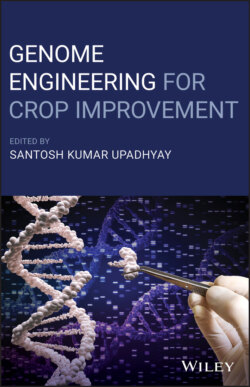Читать книгу Genome Engineering for Crop Improvement - Группа авторов - Страница 44
3.2 Evolution and Historical Perspective of Genome Engineering
ОглавлениеThe utility of biological organism, procedures and techniques to develop products for improving human life is coined as genetic engineering/biotechnology. The natural variation has been taking place since the inception of plant kingdom, with natural selection mechanisms providing the means for plants survival under adverse situations. Moreover, humans have been utilizing the phenomena of artificial selection for around 10 000 years. Modern day crops are the outcome of drastic genetic alternations caused by artificial selection procedure. These genetic variations caused by natural mutation or artificial selection are important for any crop improvement program. The hypothesis gained more ground when it became evident that phenotypic changes can occur via induced mutations. Therefore, researchers utilized reagents, radiations and chemical mutagenic agents to generate mutation in targeted genome resulting in phenotypic changes (Shu et al. 2012). The mutation breeding concept conceived in the 1940s, revolutionized plant breeding ultimately leading toward the 1970s green revolution. A major breakthrough took place with the discovery of Agrobacterium tumefaciens utilized for carrying the gene of interest in a plant's genome producing transgenic plants (Nester 2014; Schubert and Williams 2006). The following technique carries several drawbacks, i.e. disruption of endogenous genes, random mutations, foreign DNA residues called genetically modified organisms (GMOs) and failure to utilize the native plant genetic repertoire. Keeping all these disadvantages in mind, there was a dire need to precisely and efficiently edit the genome of interest for the designated objectives of plant breeding.
In the 1980s, the first genome targeting system was introduced by Mario Capecchi along with the idea of double‐strand breaks (DSBs) for genome manipulations (Capecchi 1980), and later the ability to engineer genome by site‐specific DSBs was developed (Jasin 1996). After DSBs are generated, the cell's own repair machinery can be harvested to dictate the genetic outcome through the imprecise repair process of non‐homologous end joining (NHEJ) or the precise repair process of homology‐directed repair (HDR) (Schaart et al. 2016).The NHEJ mechanism possesses the ability to make frame shift mutation through the knockout of genes (Lloyd et al. 2012). With the ability to develop multiple DSB, it became possible to make further changes in the genome, i.e. chromosomal deletion, DSBs on different genome, chromosomal translocation and gene inversion (Ferguson and Alt 2001). In comparison to NHEJ, HDR methods are more efficient, producing the more precise repairs and enabling the sequence to be assembled as per user requirement (Puchta 2005). The HDR method can be efficiently utilized for precise genomic modifications allowing a variety of templates ranging from short oligonucleotides to generate DSBs for genome editing. Proteins that can been engineered and reprogrammed to bind and cleave DNA do not exist in nature. However, it is possible to program a DNA‐binding domain to bind to any user‐defined site‐specific sequence. This domain can be fused with another domain that can cleave the DNA specifically where it binds. These bi‐modular fusion proteins are the key to precise genome engineering because they can be programmed to bind to any user‐selected sequence and generate a DSB. Such programmable site‐specific binding proteins can carry other functional domains capable of effecting other genetic and genomic changes, including transcriptional regulation, epigenetic regulation, and even base editing without generation of DSBs (Komor et al. 2016). Complete genetic engineering events are well described. A genome‐engineering tool box has three major platforms: zinc‐finger nucleases (ZFNs), transcription activator‐like effector nucleases (TALENs), and CRISPR/Cas systems. ZFNs and TALENs are protein‐based and require protein engineering for every user‐defined sequence. However, CRISPR/Cas is an RNA‐guided system and can easily be engineered to bind to the DNA target (Quétier 2016). In the current genetic engineering era, the most widely utilized is CRISPR/Cas system which will be discussed in detail to achieve crops quality improvement.
